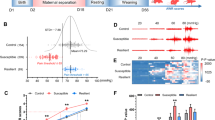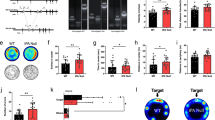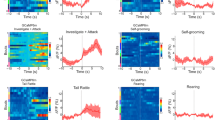Abstract
The peptide neurotransmitter substance P modulates sensitivity to pain by activating the neurokinin-1 (NK-1) receptor, which is expressed by discrete populations of neurons throughout the central nervous system1,2,3,4. Substance P is synthesized by small-diameter sensory ‘pain’ fibres5, and release of the peptide into the dorsal horn of the spinal cord following intense peripheral stimulation6 promotes central hyperexcitability and increased sensitivity to pain7,8,9,10. However, despite the availability of specific NK-1 antagonists4, the function of substance P in the perception of pain remains unclear. Here we investigate the effect of disrupting the gene encoding the NK-1 receptor in mice. We found that the mutant mice were healthy and fertile, but the characteristic amplification (‘wind up’) and intensity coding of nociceptive reflexes was absent. Although substance P did not mediate the signalling of acute pain or hyperalgesia, it was essential for the full development of stress-induced analgesia and for an aggressive response to territorial challenge, demonstrating that the peptide plays an unexpected role in the adaptive response to stress.
This is a preview of subscription content, access via your institution
Access options
Subscribe to this journal
Receive 51 print issues and online access
$199.00 per year
only $3.90 per issue
Buy this article
- Purchase on Springer Link
- Instant access to full article PDF
Prices may be subject to local taxes which are calculated during checkout





Similar content being viewed by others
References
Maeono, H., Kiyama, H. & Tohyama, M. Distribution of the substance P receptor (NK-1 receptor) in the central nervous system. Mol. Brain Res. 18, 43–58 (1993).
Nakaya, Y. et al. Immunohistochemical localization of substance P receptor in the central nervous system of the adult rat. J. Comp. Neurol. 347, 249–274 (1994).
Yokota, Y. et al. Molecular characterization of a functional cDNA for rat substance P receptor. J. Biol. Chem. 264, 17649–17652 (1989).
Maggi, C. A., Patacchini, R., Rovero, P. & Giachetti, A. Tachykinin receptors and tachykinin receptor antagonists. J. Auton. Pharmacol. 13, 23–93 (1993).
McCarthy, P. W. & Lawson, S. N. Cell type and conduction velocity of rat primary sensory neurons with substance P-like immunoreactivity. Neuroscience 28, 745–753 (1989).
Duggan, A. W., Hendry, I. A., Morton, C. R., Hutchison, W. D. & Zhao, Z. Q. Cutaneous stimuli releasing immunoreactive substance P in the dorsal horn of the cat. Brain Res. 451, 261–273 (1988).
Laird, J. M. A., Hargreaves, R. J. & Hill, R. G. Effect of RP 67580, a non-peptide neurokinin-1 receptor antagonist, on facilitation of a nociceptive spinal flexion reflex in the rat. Br. J. Pharmacol. 109, 713–718 (1993).
Ma, Q-P. & Woolf, C. J. Involvement of neurokinin receptors in the induction but not the maintenance of mechanical allodynia in rat flexor motoneurones. J. Physiol. (Lond.) 486, 769–777 (1995).
Xu, X-J., Dalsgaard, C.-J. & Wiesenfeld-Hallin, Z. Intrathecal CP-96,345 blocks reflex facilitation induced in rats by substance P and C-fiber-condtioning stimulation. Eur. J. Pharmacol. 216, 337–344 (1992).
Neumann, S., Doubell, T. P., Leslie, T. & Woolf, C. J. Inflammatory pain hypersensitivity mediated by phenotypic switch in myelinated primary sensory neurons. Nature 384, 360–364 (1996).
Nehls, M. et al. Two genetically separable steps in the differentiation of thymic epithelium. Science 272, 886–889 (1996).
Mantyh, P. W., Gates, T., Mantyh, C. R. & Maggio, J. E. Autoradiographic localization and characterization of tachykinin receptor binding sites in the rat brain and peripheral tissues. J. Neurosci. 9, 258–279 (1989).
De Felipe, C., Pinnock, R. D. & Hunt, S. P. Modulation of chemotropism in the developing spinal cord by substance P. Science 267, 899–902 (1995).
Herrero, J. F. & Headley, P. M. Functional evidence for multiple receptor activation by κ-ligands in the inhibition of spinal nociceptive reflexes in the rat. Br. J. Pharmacol. 110, 303–309 (1993).
Cervero, F. & Plenderleith, M. B. C-fibre excitation and tonic descending inhibition of dorsal horn neurones in adult rats treated at birth with capsaicin. J. Physiol. (Lond.) 365, 223–237 (1985).
Woolf, C. J. & Thompson, S. W. N. The induction and maintenance of central sensitization is dependent on N-methyl-D-aspartic acid receptor activation; implications for the treatment of post-injury pain hypersensitivity states. Pain 44, 293–299 (1991).
König, M. et al. Pain responses, anxiety and aggression in mice deficient in pre-proenkephalin. Nature 383, 535–538 (1996).
Yaksh, T. L. & Malmbery, A. B. in The Textbook of Pain(eds Wall, P. D. & Melzack, R.) 165–200 (Churchill-Livingstone, London, (1994)).
Bozic, C. R., Lu, B., Höpken, U. E., Gerard, C. & Gerard, N. P. Neurogenic amplification of immune complex inflammation. Science 273, 1722–1725 (1996).
Noguchi, K. & Ruda, M. A. Gene regulation in an ascending nociceptive pathway: inflammation-induced increase in preprotachykinin mRNA in rat lamina I spinal projection neurons. J. Neurosci. 12, 2563–2572 (1992).
Abbadie, C., Taylor, B. K., Peterson, M. A. & Basbaum, A. I. Differential contribution of the two phases of the formalin test to the pattern of c-fos expression in the rat spinal cord: studies with remifentanil and lodocaine. Pain 69, 101–110 (1997).
Rupniak, N. M. J., Carlson, E., Boyce, S., Webb, J. K. & Hill, R. G. Enantioselective inhibition of the formalin paw late phase by the NK1receptor antagonist L-733,060 in gerbils. Pain 67, 189–195 (1996).
Hunt, S. P., Pini, A. & Evan, G. Induction of c-fos-like protein in spinal cord neurons following sensory stimulation. Nature 328, 632–634 (1987).
Chapman, V., Buritova, J., Honoré, P. & Besson, J.-M. Physiological contributions of neurokinin 1 receptor activation, and interactions with NMDA receptors, to inflammatory-evoked spinal c-Fos expression. J. Neurophysiol. 76, 1817–1827 (1996).
Rubinstein, M. et al. Absence of opioid stress-induced analgesia in mice lacking β-endorphin by site-directed mutagenesis. Proc. Natl Acad. Sci. USA 93, 3995–4000 (1996).
Marek, P., Mogil, J. S., Sternberg, W. F., Panocka, I. & Liebeskind, J. C. N-Methyl-D-aspartic acid (NMDA) receptor antagonist MK-801 blocks non-opioid stress-induced analgesia. II. Comparison across three swim-stress paradigms in selectively bred mice. Brain Res. 578, 197–202 (1992).
Vanderah, T. W. et al. Mediation of swim-stress antinociception by the opioid delta2 receptor in the mouse. J. Pharmacol. Exp. Therapeut. 262, 190–197 (1992).
Jessell, T. M. & Iversen, L. L. Opiate analgesics inhibit substance P release from rat trigeminal nucleus. Nature 268, 549–551 (1977).
Siegel, A., Schubert, K. & Shaiku, M. B. Neurochemical mechanisms underlying amygdaloid modulation of aggressive behaviour in the cat. Aggr. Behav. 21, 49–62 (1995).
Acknowledgements
We thank N. Unwin, W. Wisden, R. Munglani and R. Twyman for reading the manuscript; S. Nakanishi for the NK1 receptor cDNA; J. Ure, A. Jones, C. Roza and L. Singh for technical advice or assistance; S. Ingham for photographic assistance; P. Mantyh for suggestions and discussion. This work was supported by grants from MRC-ROPA, BBSRC, EC and DGICYT.
Author information
Authors and Affiliations
Corresponding author
Supplementary Information
Rights and permissions
About this article
Cite this article
Felipe, C., Herrero, J., O'Brien, J. et al. Altered nociception, analgesia and aggression in mice lacking the receptor for substance P. Nature 392, 394–397 (1998). https://doi.org/10.1038/32904
Received:
Accepted:
Issue Date:
DOI: https://doi.org/10.1038/32904
This article is cited by
-
Hemokinin-1 is a mediator of chronic restraint stress-induced pain
Scientific Reports (2023)
-
Neuropeptidergic regulation of compulsive ethanol seeking in C. elegans
Scientific Reports (2022)
-
A high plane of nutrition during early life alters the hypothalamic transcriptome of heifer calves
Scientific Reports (2021)
-
Control of impulsivity by Gi-protein signalling in layer-5 pyramidal neurons of the anterior cingulate cortex
Communications Biology (2021)
-
Mutually suppressive roles of KMT2A and KDM5C in behaviour, neuronal structure, and histone H3K4 methylation
Communications Biology (2020)
Comments
By submitting a comment you agree to abide by our Terms and Community Guidelines. If you find something abusive or that does not comply with our terms or guidelines please flag it as inappropriate.



